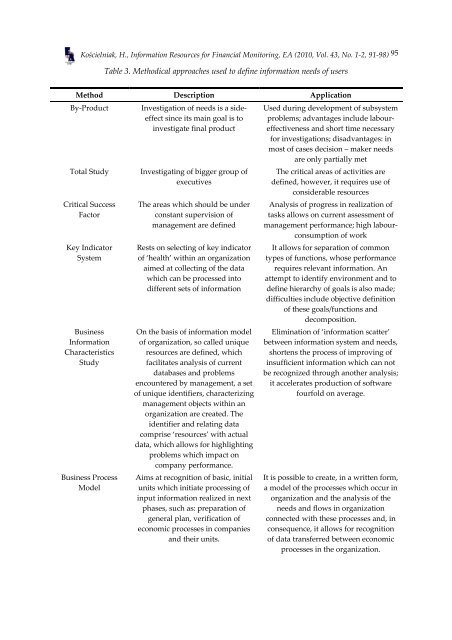Twice a Year Scientific Journal
Twice a Year Scientific Journal
Twice a Year Scientific Journal
Create successful ePaper yourself
Turn your PDF publications into a flip-book with our unique Google optimized e-Paper software.
Kościelniak, H., Information Resources for Financial Monitoring, EA (2010, Vol. 43, No. 1-2, 91-98) 95<br />
Table 3. Methodical approaches used to define information needs of users<br />
Method Description Application<br />
By-Product Investigation of needs is a sideeffect<br />
since its main goal is to<br />
investigate final product<br />
Used during development of subsystem<br />
problems; advantages include laboureffectiveness<br />
and short time necessary<br />
for investigations; disadvantages: in<br />
most of cases decision – maker needs<br />
are only partially met<br />
Total Study<br />
Critical Success<br />
Factor<br />
Key Indicator<br />
System<br />
Business<br />
Information<br />
Characteristics<br />
Study<br />
Business Process<br />
Model<br />
Investigating of bigger group of<br />
executives<br />
The areas which should be under<br />
constant supervision of<br />
management are defined<br />
Rests on selecting of key indicator<br />
of ‘health’ within an organization<br />
aimed at collecting of the data<br />
which can be processed into<br />
different sets of information<br />
On the basis of information model<br />
of organization, so called unique<br />
resources are defined, which<br />
facilitates analysis of current<br />
databases and problems<br />
encountered by management, a set<br />
of unique identifiers, characterizing<br />
management objects within an<br />
organization are created. The<br />
identifier and relating data<br />
comprise ‘resources’ with actual<br />
data, which allows for highlighting<br />
problems which impact on<br />
company performance.<br />
Aims at recognition of basic, initial<br />
units which initiate processing of<br />
input information realized in next<br />
phases, such as: preparation of<br />
general plan, verification of<br />
economic processes in companies<br />
and their units.<br />
The critical areas of activities are<br />
defined, however, it requires use of<br />
considerable resources<br />
Analysis of progress in realization of<br />
tasks allows on current assessment of<br />
management performance; high labourconsumption<br />
of work<br />
It allows for separation of common<br />
types of functions, whose performance<br />
requires relevant information. An<br />
attempt to identify environment and to<br />
define hierarchy of goals is also made;<br />
difficulties include objective definition<br />
of these goals/functions and<br />
decomposition.<br />
Elimination of ‘information scatter’<br />
between information system and needs,<br />
shortens the process of improving of<br />
insufficient information which can not<br />
be recognized through another analysis;<br />
it accelerates production of software<br />
fourfold on average.<br />
It is possible to create, in a written form,<br />
a model of the processes which occur in<br />
organization and the analysis of the<br />
needs and flows in organization<br />
connected with these processes and, in<br />
consequence, it allows for recognition<br />
of data transferred between economic<br />
processes in the organization.
















